A well-planned garden setup can completely change the look and feel of your yard. It’s not just about aesthetics; it’s about creating a space that’s both beautiful and productive. Whether you’re growing flowers, herbs, or vegetables, the right design can make all the difference.
Steven Biggs, a renowned expert in edible landscaping, emphasizes the importance of strategic design. By using creative layouts and maximizing space, you can boost your yields while enhancing your home’s curb appeal. His methods are perfect for those with small yards or shaded areas, offering solutions for multi-season harvests.
From raised beds to vertical gardening, there are countless ideas to explore. Companion planting and soil optimization are also key to a thriving garden. These techniques not only save space but also promote healthier plants and better results.
Key Takeaways
- A well-planned garden setup enhances both beauty and productivity.
- Strategic design maximizes yields and improves curb appeal.
- Steven Biggs’ methods are ideal for small or shaded spaces.
- Raised beds and vertical gardening save space and boost growth.
- Companion planting and soil optimization lead to healthier plants.
1. Why a Well-Planned Garden Setup Matters
Strategic design is the key to a thriving and efficient outdoor space. A thoughtful layout not only enhances the beauty of your yard but also ensures a bountiful harvest. By focusing on intentional designs, you can reduce maintenance while increasing yields.
Sunlight mapping is crucial for plant health. Most vegetables and plants require 6-8 hours of daily sunlight. Positioning your garden to face south, east, or west ensures optimal exposure. Miracle-Gro emphasizes the importance of proximity to water sources for consistent hydration.
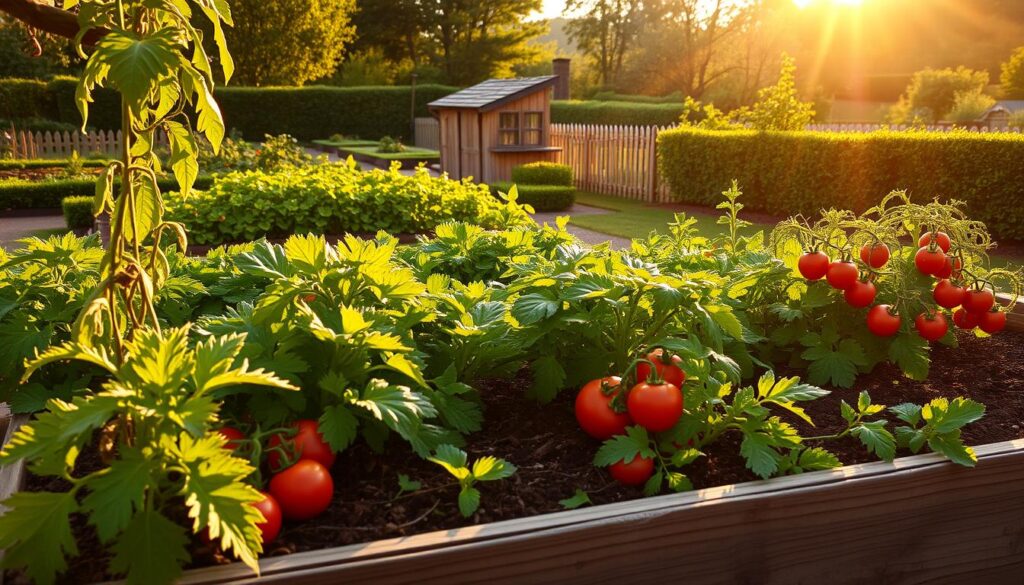
Crop rotation is another essential practice. It prevents soil depletion by alternating plant families each season. This method maintains soil fertility and reduces the risk of pests and diseases. As Steven Biggs advises, “Grow what you love, but avoid space-hogging plants like Brussels sprouts.”
Companion planting offers multiple benefits. Pairing certain plants together can deter pests and improve nutrient sharing. For example, planting basil near tomatoes enhances flavor and repels insects. This natural way of pest control keeps your garden healthy without chemicals.
Prioritizing high-yield crops is a smart strategy. Bush beans, for instance, produce more food in less space compared to low-output edamame. This approach maximizes your garden’s potential, ensuring a plentiful harvest throughout the season.
2. Assessing Your Yard for the Best Garden Setup
Understanding your yard’s unique features is the first step to creating a thriving outdoor space. Start by evaluating the sunlight patterns. Most plants need 6-8 hours of direct sun daily. Use a sun map or observe the area hourly to identify the brightest spots.
Next, test your soil for pH and drainage. Amend it with compost or sand if needed. Healthy soil ensures better plant growth and reduces maintenance. Avoid planting near walnut trees, as they release toxins harmful to vegetables.
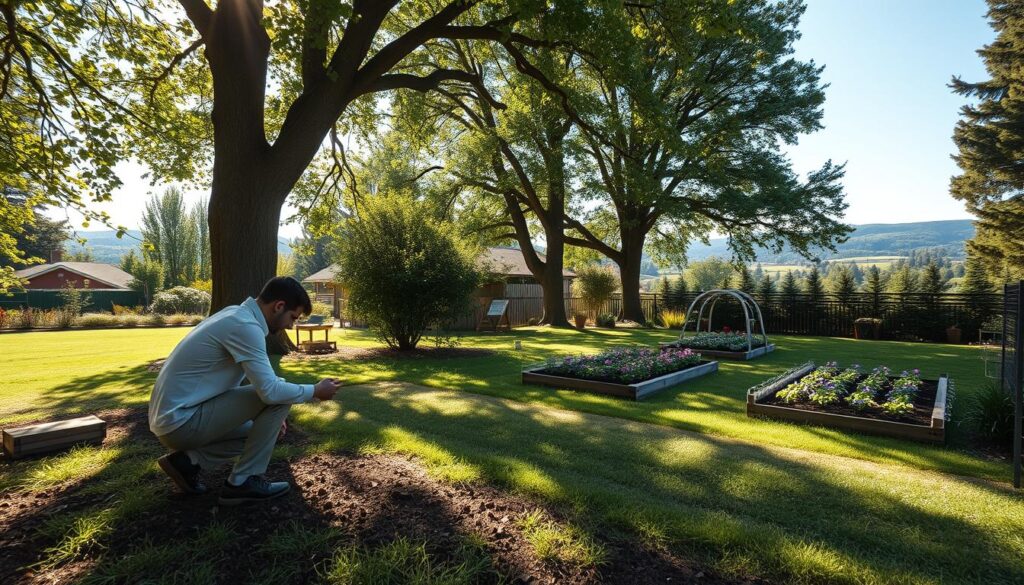
Identify microclimates in your yard. Shaded corners are perfect for leafy greens, while sunny spots suit tomatoes and peppers. Steven Biggs recommends vertical gardening for shaded areas to maximize space.
Measure the available space for raised beds, containers, or in-ground plots. Use graph paper to sketch beds and pathways proportionally. This helps visualize the layout and ensures efficient use of the area.
Finally, prioritize easy water access. Miracle-Gro emphasizes the importance of consistent hydration for plant health. A well-planned setup saves time and effort, making your outdoor project more enjoyable.
3. Choosing the Right Plants for Your Garden
Your plant choices can make or break your gardening success. Start by selecting heat-loving or cool-season crops based on your USDA zone. This ensures your plants thrive in the local climate.
For small spaces, prioritize compact varieties like patio tomatoes or bush beans. These plants grow well in containers and save valuable space. Steven Biggs advises avoiding “stingy crops” like edamame, which yield little for the space they occupy.
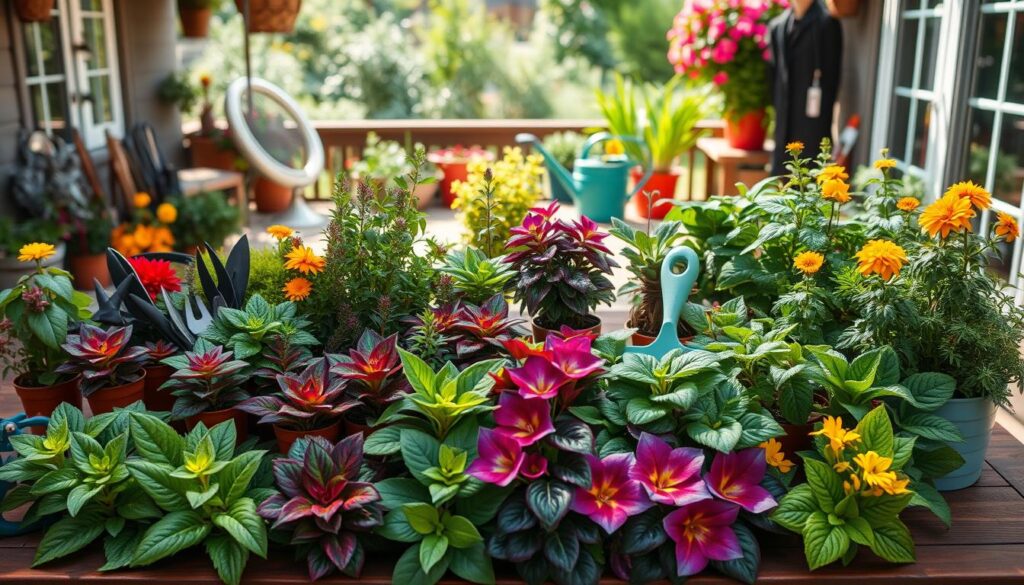
Integrate pollinator attractors such as marigolds and lavender. Miracle-Gro highlights their importance in boosting yields by attracting bees and butterflies. These plants also add color and fragrance to your outdoor space.
Use vertical supports for vining plants like cucumbers and pole beans. This technique maximizes space and improves air circulation, reducing the risk of disease. Mixing perennials like asparagus and strawberries with annuals ensures staggered harvests throughout the year.
“Grow what you love, but focus on plants that give you the most bang for your buck,” says Steven Biggs.
Here’s a quick guide to help you choose the right plants:
| Heat-Loving Crops | Cool-Season Crops |
|---|---|
| Tomatoes | Spinach |
| Peppers | Lettuce |
| Beans | Kale |
By carefully selecting your plants, you can create a vibrant and productive outdoor space. Whether you’re growing vegetables, fruit, or ornamental flowers, the right choices lead to a thriving garden.
4. Designing Your Vegetable Garden Layout
A smart layout can turn your yard into a productive and beautiful space. Whether you’re working with a large plot or a tiny corner, the right design ensures your plants thrive. Let’s explore two popular methods: raised beds and in-ground planting, along with vertical gardening for small spaces.
Raised Beds vs. In-Ground Planting
Raised beds offer several advantages. They improve drainage, reduce soil compaction, and make it easier to control weeds. For those with limited mobility, raised beds are a great way to garden comfortably. In-ground planting, on the other hand, is ideal for larger areas and can be more cost-effective.
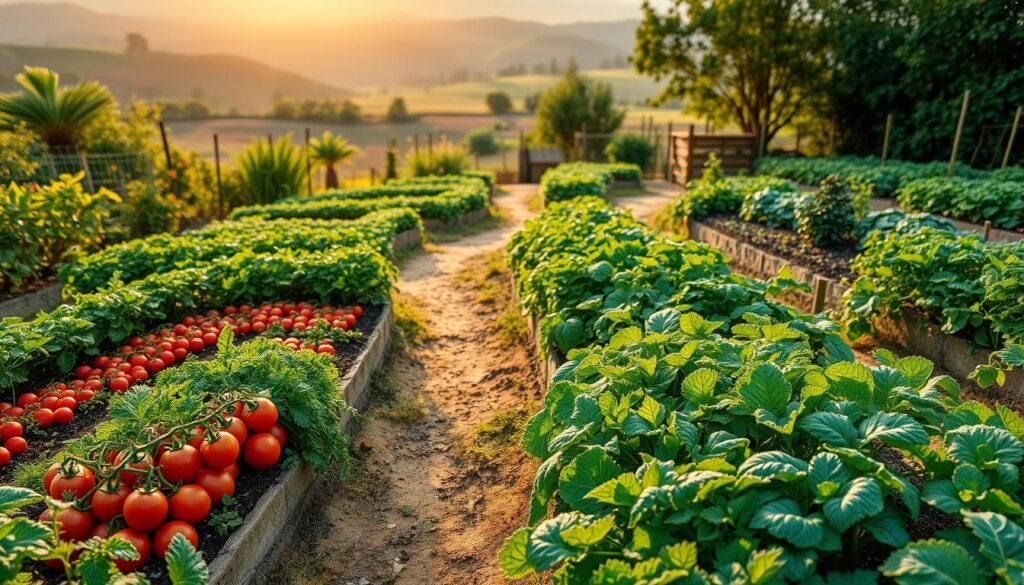
| Raised Beds | In-Ground Planting |
|---|---|
| Better drainage | Cost-effective |
| Easier weed control | Ideal for large areas |
| Accessible for all gardeners | Requires less initial setup |
Vertical Gardening for Small Spaces
Vertical gardening is a game-changer for small space gardeners. By growing upwards, you can maximize your area and grow more plants. Steven Biggs recommends using A-frame cucumber trellises with shade-tolerant greens underneath. This method not only saves space but also creates a visually appealing setup.
Here are some creative ideas:
- Install trellises for peas, malabar spinach, and achocha.
- Use hanging baskets for strawberries and herbs.
- Repurpose ladders or pallets for tiered planters.
- Pair vertical structures with shade-loving crops like lettuce.
- Maximize driveway or balcony space with stacked containers.
Vertical gardening is a great way to grow more in less area. It’s perfect for urban gardeners or anyone looking to make the most of their outdoor space. With a little creativity, you can transform even the smallest area into a thriving vegetable garden.
5. Building Raised Beds for Your Garden
Raised beds offer a versatile solution for growing plants efficiently. They provide better control over soil quality, drainage, and accessibility. Whether you’re a beginner or an experienced gardener, these tips will help you create a functional and long-lasting setup.
Start by choosing rot-resistant materials like cedar or composite for your beds. These options ensure durability and reduce maintenance over time. Brick frames are another excellent choice for a sturdy and aesthetic design.

Layer your raised beds properly for optimal plant growth. Begin with cardboard to suppress weeds, followed by compost and topsoil. This method enriches the soil and provides a nutrient-rich environment for your plants.
For ergonomic gardening, build accessible beds with a height of 24-36 inches. This design reduces strain on your back and knees, making it easier to tend to your plants. Steven Biggs suggests using straw bales as a temporary alternative. They’re nutrient-rich and perfect for seasonal planting.
Incorporate drip irrigation during construction to ensure consistent watering. This system saves time and keeps your plants hydrated efficiently. Here’s a quick comparison of materials for raised beds:
| Material | Benefits |
|---|---|
| Cedar | Rot-resistant, durable |
| Composite | Low maintenance, long-lasting |
| Brick | Sturdy, aesthetic |
| Straw Bales | Temporary, nutrient-rich |
With these tips, you can create a thriving outdoor space using raised beds. Whether you’re growing vegetables, herbs, or flowers, this method ensures a productive and enjoyable gardening experience.
6. Companion Planting for a Thriving Garden
Companion planting is a natural way to boost your garden’s health and productivity. By pairing certain plants together, you can improve growth, deter pests, and enhance flavor. This method has been used for centuries and is backed by science, as highlighted in Miracle-Gro’s book, Plant Partners.

One classic example is planting basil near tomatoes. Basil repels hornworms, a common pest for tomatoes, while also enhancing their flavor. Similarly, nasturtiums work well with squash, acting as a trap crop for aphids. These pairings not only protect your plants but also add beauty to your outdoor space.
Steven Biggs recommends pairing radishes with carrots. Radishes grow quickly, loosening the soil for carrots, which take longer to mature. This combination maximizes space and ensures both crops thrive. Another effective duo is corn and pole beans. Corn provides a natural trellis for beans, while beans fix nitrogen in the soil, benefiting corn.
Garlic is another versatile plant in companion planting. It deters pests from roses and raspberries, making it a great addition to ornamental and edible gardens. However, not all plants work well together. For example, onions and peas are incompatible, as onions can stunt pea growth.
Here’s a quick guide to successful companion planting:
- Plant basil with tomatoes to repel hornworms.
- Grow nasturtiums with squash as a trap crop for aphids.
- Pair corn with pole beans for mutual benefits.
- Use garlic to protect roses and raspberries.
- Avoid planting onions near peas.
For more tips on starting your outdoor project, check out this beginner’s guide to gardening. Companion planting is a simple yet powerful way to create a thriving and productive space.
7. Maximizing Space with Vertical Gardening
Vertical gardening is a smart way to make the most of limited outdoor areas. Whether you have a tiny balcony or a narrow driveway, growing upwards can transform your space. Steven Biggs, for example, uses driveway tomato containers to grow thriving plants in unconventional spots.

For those with small space, vertical structures like cattle panel arches are ideal. Train indeterminate tomatoes on these arches to save ground area. Pair them with shade-tolerant greens underneath for a layered effect. This method not only maximizes space but also creates a visually appealing setup.
Consider using tall pots for dwarf fruit trees like lemons and figs. These compact trees thrive in containers and add both beauty and functionality to your outdoor area. Pocket planters on fences are another great option for herbs and succulents, making use of vertical surfaces.
Wall-mounted gutter systems are perfect for growing salad greens. They’re easy to install and keep your plants within reach. Combine these vertical layers with ground-level pollinator plants like marigolds to attract beneficial insects.
Here’s a quick comparison of vertical gardening methods:
| Method | Best Use |
|---|---|
| Cattle Panel Arches | Tomatoes and vining plants |
| Tall Pots | Dwarf fruit trees |
| Pocket Planters | Herbs and succulents |
| Gutter Systems | Salad greens |
By incorporating these ideas, you can create a productive and beautiful outdoor space, even in the smallest areas. Vertical gardening is a versatile solution for urban gardeners and anyone looking to maximize their yard.
8. Soil Preparation and Fertilization Tips
Healthy soil is the foundation of a thriving outdoor space. Without proper preparation, even the best plants may struggle to grow. Start by testing your soil’s pH. Most vegetables thrive in a range of 6.0 to 7.0. A simple test kit can help you determine if adjustments are needed.
If you have clay soil, amend it with gypsum and organic matter like compost. This improves drainage and creates a better environment for roots to grow. Miracle-Gro’s Garden Soil for Vegetables & Herbs is an excellent option for enriching your beds with essential nutrients.
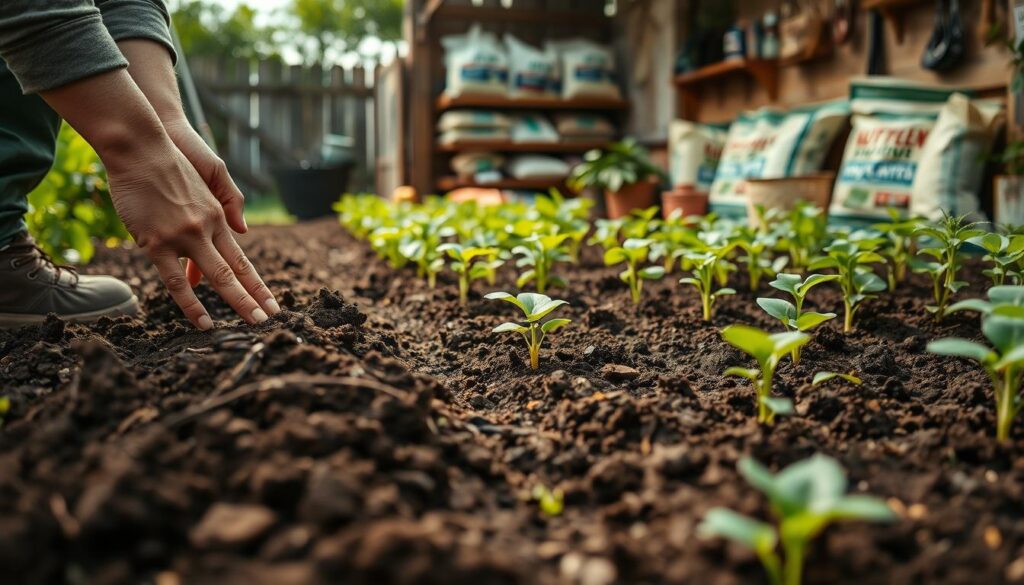
Regular fertilization is key to maintaining healthy plants. Side-dress your crops with compost tea every 3-4 weeks. This provides a steady supply of nutrients without overwhelming the soil. Worm castings are another great choice for slow-release fertilizer.
Steven Biggs recommends rotating heavy feeders like tomatoes with soil builders like beans. This practice maintains soil fertility and prevents nutrient depletion. For example, planting rapini after garlic ensures the soil remains balanced and productive.
Finally, ensure your plants get enough sun. Most vegetables need 6-8 hours of direct sunlight daily. Position your beds to maximize exposure and watch your plants thrive. With these tips, you’ll create a nutrient-rich environment that supports healthy growth and abundant harvests.
9. Watering Strategies for a Healthy Garden
Efficient water use is essential for a thriving outdoor space. By adopting smart techniques, you can keep your plants hydrated while conserving resources. Let’s explore some effective strategies to optimize your watering routine.
Water deeply in the morning to reduce evaporation. This ensures your plants absorb moisture before the sun gets too intense. Miracle-Gro recommends using drip irrigation systems for consistent hydration. These systems deliver water directly to the roots, minimizing waste.
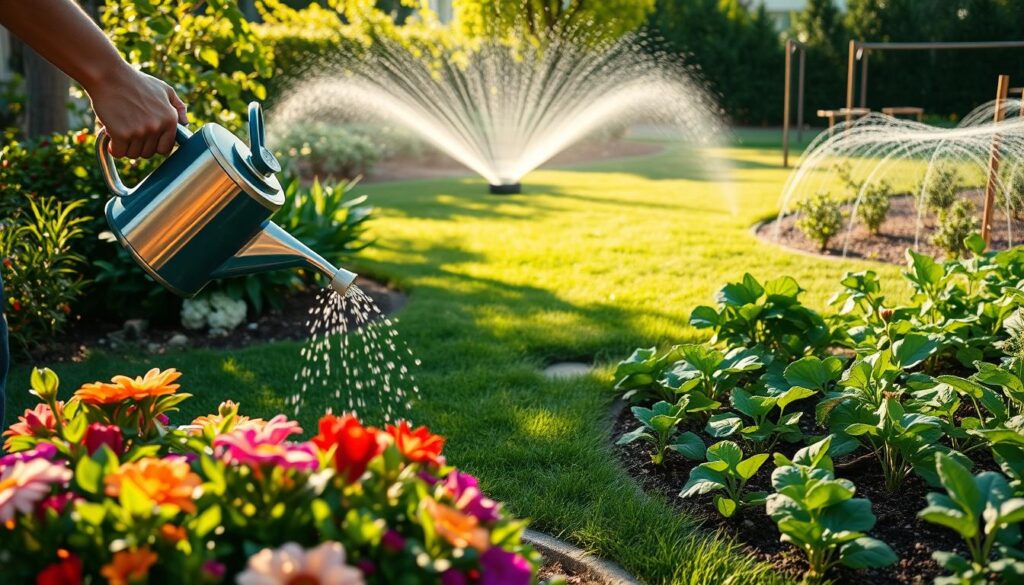
Install soaker hoses under mulch for added efficiency. This method keeps the soil moist and reduces the time spent watering. Steven Biggs suggests using ollas (clay pots) for slow root-zone hydration. These pots release water gradually, ensuring your plants stay hydrated even during dry spells.
Collect rainwater in barrels to prepare for drought periods. This eco-friendly way to water your plants is both cost-effective and sustainable. Group plants by their water needs to avoid over or under-watering. For example, zucchini requires more water than lavender, so plant them separately.
Here’s a quick comparison of watering methods:
| Method | Benefits |
|---|---|
| Drip Irrigation | Consistent hydration, reduces waste |
| Soaker Hoses | Efficient, keeps soil moist |
| Ollas | Slow root-zone hydration |
| Rainwater Barrels | Eco-friendly, cost-effective |
By implementing these strategies, you can ensure your plants thrive throughout the growing season. For more tips on starting your outdoor project, check out this beginner’s guide to gardening.
10. Seasonal Planting and Succession Crops
Planning your planting schedule can transform your outdoor space into a year-round haven. By aligning your crops with the changing seasons, you can ensure a continuous harvest and make the most of your growing area.
Start in spring with cool-weather favorites like peas and spinach. As temperatures rise, transition to summer staples such as beans and tomatoes. Steven Biggs recommends planting rapini after garlic to maintain soil health and maximize space. This method ensures your outdoor area remains productive throughout the year.

For fall, plant brassicas like kale and broccoli 10-12 weeks before the first frost. These hardy crops thrive in cooler weather and extend your growing season. Interplanting radishes with slower-growing carrots is another smart strategy. Radishes mature in just 25 days, leaving room for carrots to develop.
Cold frames are a great way to extend your growing time. They protect plants from frost and allow you to grow greens well into winter. Scheduling 3-4 successions of lettuce ensures a steady supply of fresh leaves. The Almanac’s 800+ Garden Planner layouts can help you design a planting schedule tailored to your region.
With thoughtful planning, you can enjoy a bountiful harvest from spring through fall. Whether you’re a beginner or an experienced gardener, these strategies make it easy to keep your outdoor space productive and vibrant.
11. Maintaining Your Garden for Long-Term Success
Keeping your outdoor space thriving requires consistent care and attention. With the right plan, you can ensure your plants stay healthy and productive throughout the season. Let’s explore some practical tips to help you maintain a vibrant and sustainable area.
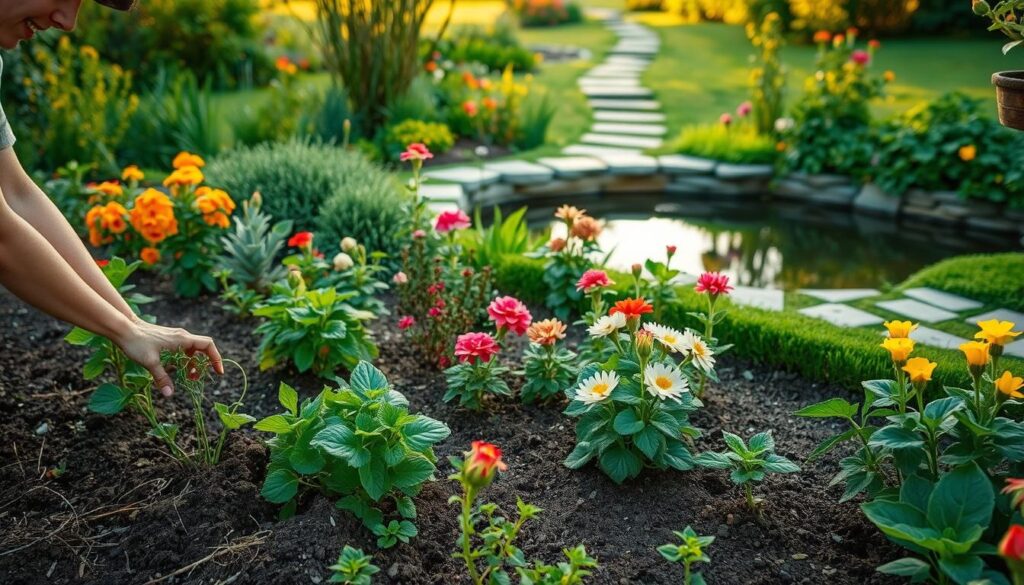
Start by pruning tomatoes regularly to improve airflow and prevent diseases. Miracle-Gro’s Shake ‘n Feed® Tomato fertilizer is an excellent choice for providing essential nutrients. Steven Biggs recommends refreshing mulch monthly to retain moisture and block weeds. This simple step keeps your beds in top condition.
Inspect your plants daily for pests like caterpillars and aphids. Handpick them to avoid infestations. Sterilize your tools between uses to prevent cross-contamination. These small habits make a big difference in the long run.
As the season comes to an end, winterize your beds with cover crops like clover or rye. These plants protect the soil and add nutrients for the next growing cycle. By following these strategies, you’ll enjoy a flourishing outdoor space year after year.
12. Conclusion: Enjoy the Fruits of Your Labor
Your hard work in the yard will soon pay off with a bountiful harvest. From vertical gardening to succession planting, your strategies have set you up for success. Healthy soil and smart planning ensure your outdoor space thrives year after year.
Keep a journal to track what works best. Note which tomato varieties flourish or which plants pair well together. This way, you can refine your plan for even better results next season.
Consider expanding your space with new beds or fruit trees. Fresh, homegrown meals are a rewarding way to enjoy your efforts while cutting grocery costs. As the season comes to an end, take pride in what you’ve accomplished.
For more advanced tips, tune into Steven Biggs’ Food Garden Life podcast. Your gardening journey is just beginning, and the possibilities are endless.

